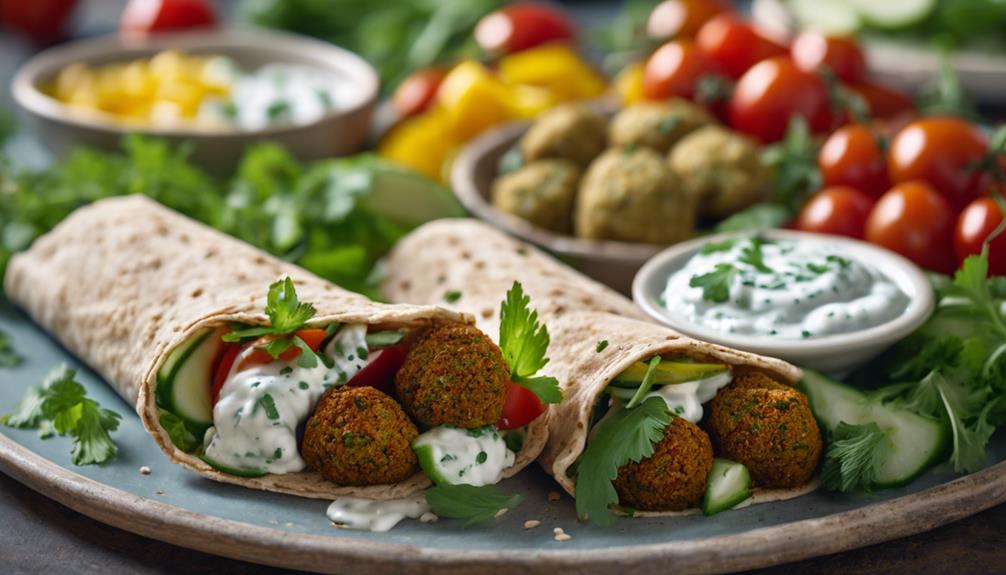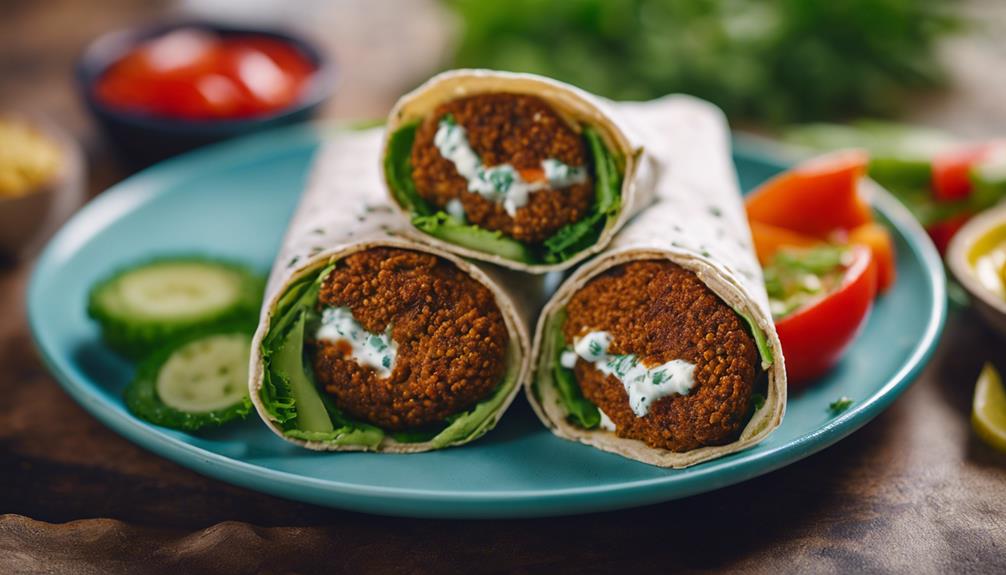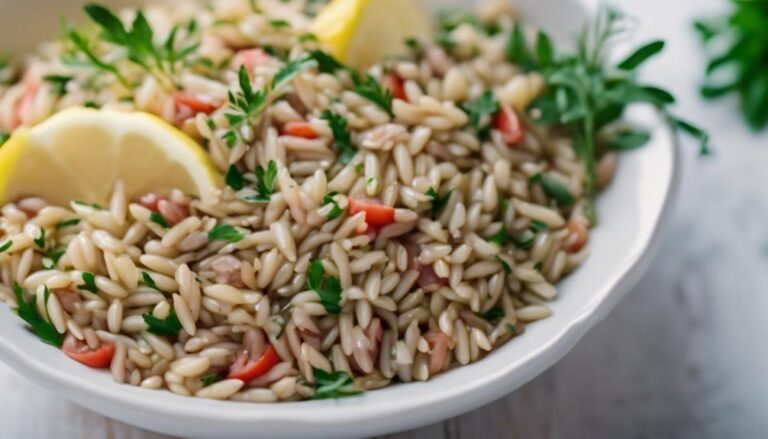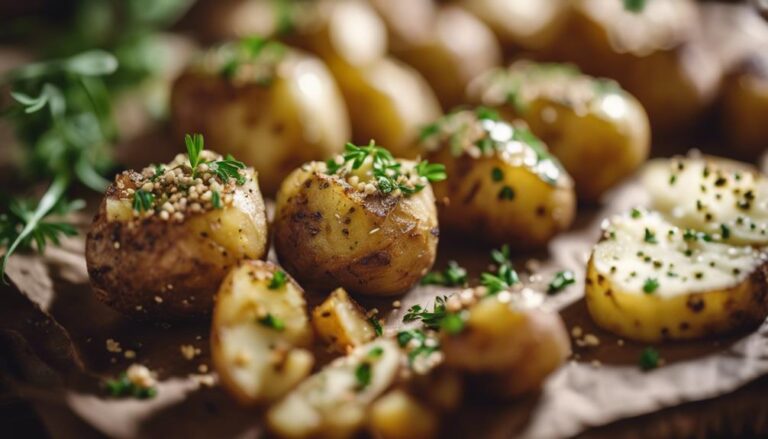Sous Vide Whole Wheat Falafel Wraps With Tzatziki
Indulge in a modern twist on traditional falafel! Create whole wheat falafel wraps using the sous vide method for flavorful outcomes. The falafel, packed with chickpeas, cumin, and coriander, develops a tender texture with precise temperature control. Pair it with creamy tzatziki sauce for a delightful combination. Experiment with different falafel variations like chickpea and spinach or spicy harissa blends for unique flavors. Learn to adjust frying times based on falafel size and density and maintain consistent quality by organizing the frying process into batches. Enhance your falafel experience with fusion of flavors and textures.
What You Will Learn Here
- Sous vide method ensures precise cooking temperature for falafel.
- Whole wheat falafel wraps offer a healthier twist to traditional recipe.
- Tzatziki adds a creamy, tangy element to the dish.
- Wraps provide a convenient and portable way to enjoy falafel.
- Combination of flavors and textures create a satisfying meal experience.
Falafel's Middle Eastern Origins

Falafel, a beloved Middle Eastern dish, has a rich history that dates back centuries.
Traditional ingredients like chickpeas, herbs, and spices are essential to its authentic taste.
Over time, cooking techniques have evolved, leading to various regional variations of this flavorful and satisfying dish.
Falafel History Overview
Originating in the Middle East, the history of falafel is a rich tapestry woven with cultural influences and culinary traditions.
Falafel's origins can be traced back to ancient Egypt, where it was initially made with fava beans. Over time, the recipe evolved, and chickpeas became the primary ingredient, as they were more readily available in the region.
The cultural significance of falafel is profound, symbolizing the diverse flavors and textures of Middle Eastern cuisine. This popular dish spread throughout the Middle East and beyond, becoming a staple in vegetarian diets worldwide.
Today, falafel continues to be enjoyed for its crispy exterior, tender interior, and aromatic blend of herbs and spices, making it a beloved part of Middle Eastern culinary heritage.
Traditional Ingredients Used
With its deep roots in ancient Egypt, falafel's traditional ingredients harken back to the heart of Middle Eastern culinary heritage. The key components of authentic falafel include ground chickpeas or fava beans, combined with aromatic traditional spices such as cumin, coriander, and garlic.
These spices not only enhance the flavor but also provide a rich depth that's characteristic of Middle Eastern cuisine. The mixture is then formed into small patties and deep-fried to achieve a crispy exterior while maintaining a moist and flavorful interior.
This cooking method guarantees that the falafel achieves the perfect texture and taste, making it a beloved dish across the Middle East and beyond.
Cooking Techniques Evolution
During the evolution of cooking techniques in the Middle East, the preparation of falafel underwent significant transformations, enhancing both its texture and flavor profile. Traditionally deep-fried, the introduction of sous vide cooking brought about a revolution in falafel making. Sous vide advantages include precise temperature control that guarantees the falafel remains moist while cooking evenly.
However, some argue that the lack of a crispy outer layer is a drawback of this method. Tzatziki, a traditional sauce served with falafel, has also seen flavor variations over time. Some regions prefer a tangier tzatziki with more lemon juice, while others opt for a milder version with extra garlic. These variations add depth to the overall experience of enjoying falafel wraps with tzatziki.
Key Falafel Ingredients

To guarantee flavorful and authentic falafel, the key ingredients must include chickpeas, fresh parsley, aromatic spices, and garlic. These ingredients come together to form the perfect mixture for delicious falafel balls.
- Chickpeas: The main ingredient in falafel, chickpeas provide a nutty flavor and a satisfying texture to the dish.
- Fresh Parsley: Adding a burst of freshness, fresh parsley enhances the falafel's overall taste and aroma.
- Aromatic Spices: A blend of cumin, coriander, and other spices gives falafel its distinctive Middle Eastern flavor profile.
When preparing falafel, having the right balance of these key ingredients is crucial. The chickpeas should be soaked and ground to a coarse texture, while the fresh parsley and aromatic spices should be finely chopped and incorporated evenly into the mixture. By paying attention to these key ingredients and their proportions, you can be certain that your falafel turns out perfectly seasoned and full of flavor.
Top-Rated Falafel Variations
Looking to elevate your falafel game? Try out these top-rated falafel variations: Whole Wheat Falafel With Hummus, Chickpea and Spinach Falafel, and Spicy Harissa Falafel Blend.
Each variation offers a unique twist on the classic falafel, bringing distinct flavors and textures to your dish. Whether you're a fan of traditional recipes or looking to experiment with new flavors, these top-rated falafel variations are sure to satisfy your cravings.
Whole Wheat Falafel With Hummus
Indulge in the satisfying crunch of whole wheat falafel paired with creamy hummus, a top-rated variation loved for its wholesome flavors and textures. Whole wheat benefits bring extra fiber and nutrients to this classic dish. When preparing whole wheat falafel, consider baking instead of frying for a healthier option.
The nutty flavor of whole wheat adds depth to the falafel, enhancing its overall taste. Pair these falafel balls with a velvety smooth hummus for a delightful contrast in textures and flavors. The creamy hummus complements the crunchy exterior of the falafel, creating a harmonious combination that will surely tantalize your taste buds.
Serve this dish with a side of fresh salad or pickled vegetables for a complete and satisfying meal.
Chickpea and Spinach Falafel
For a flavorful twist on traditional falafel, consider trying out the top-rated variation of Chickpea and Spinach Falafel that combines the earthy taste of chickpeas with the vibrant freshness of spinach. This fusion creates a falafel that isn't only delicious but also packed with nutrients. Here is a quick overview:
- Chickpea Alternatives: The use of chickpeas offers a creamy texture and nutty flavor, which can be swapped with other legumes like lentils for a different taste profile.
- Spinach Variations: Spinach adds a pop of color and a dose of freshness to the falafel mix. You can experiment with kale or arugula for a unique twist.
- Nutrient-Rich Blend: This falafel variation isn't only tasty but also a great source of plant-based protein, fiber, and essential vitamins and minerals.
Spicy Harissa Falafel Blend
To take your falafel experience up a notch, explore the bold and fiery flavors of the Spicy Harissa Falafel Blend, a top-rated variation that promises a kick of heat and depth of taste. This Middle Eastern fusion combines the traditional falafel with the spicy kick of Harissa, creating a unique and flavorful twist. Here's what to expect when you try this innovative blend:
- Spicy Harissa: The blend includes a generous amount of Spicy Harissa, adding a fiery heat that sets it apart from traditional falafel.
- Middle Eastern Fusion: It beautifully combines the flavors of the Middle East with the classic falafel ingredients, creating a harmonious fusion.
- Whole Wheat: This cooking innovation introduces whole wheat into the mix, adding a nutty and wholesome element to the falafel's texture.
Falafel Frying Techniques
To guarantee your falafel turns out perfectly crispy on the outside and tender on the inside, mastering oil temperature control is key.
Adjusting frying times based on the size and texture of your falafel mixture can make a significant difference in the final product.
Additionally, consider batching your falafel for efficient frying, allowing you to maintain consistent oil temperature and ensure even cooking throughout.
Oil Temperature Control
Maintaining the ideal oil temperature when frying falafel is essential for achieving a crispy exterior and a perfectly cooked interior. The perfect oil temperature for frying falafel is around 350°F (175°C).
At this temperature, the falafel cooks evenly, ensuring a golden-brown crust while keeping the inside moist and flavorful. If the oil temperature is too low, the falafel will absorb more oil, resulting in a greasy texture and a less crispy exterior.
On the other hand, if the oil temperature is too high, the falafel may burn on the outside before the inside is fully cooked, affecting its flavor profile. So, make sure to use a thermometer to monitor the oil temperature throughout the frying process for delicious, perfectly fried falafel.
Frying Time Adjustments
For achieving ideal falafel texture and flavor, consider adjusting the frying time based on the size and density of your falafel mixture. When frying falafel, you have the opportunity to control the texture by adjusting the temperature and frying time.
If your falafel balls are on the larger side or have a denser consistency, you may need to extend the frying time slightly to guarantee they cook through evenly. Keep an eye on the color and crispiness of the falafel to gauge when they're ready.
Adjusting the temperature of the oil can also help in achieving the desired texture – a slightly lower temperature can prevent the outside from burning before the inside is fully cooked. Experiment with different frying times and temperatures to find the perfect balance for your falafel.
Batching for Efficiency
Consider organizing your falafel frying process into batches to enhance efficiency and maintain consistent quality throughout the cooking process.
Efficient meal prep relies on time-saving strategies like this. Start by forming all your falafel balls before beginning to fry. This way, you can focus solely on frying once you start.
Use a deep fryer or a deep pan with enough oil to submerge the falafel completely for even cooking. Keep an eye on the temperature to guarantee the falafel cooks through without burning.
Work in small batches, so you don't overcrowd the frying space, which can lower the oil temperature and make the falafel greasy.
Final Thoughts
In conclusion, ponder the delightful fusion of flavors and textures in these wholesome Whole Wheat Falafel Wraps with Tzatziki. Reflections on this recipe reveal a harmonious marriage between the nutty undertones of the whole wheat falafel, the freshness of the crisp vegetables, and the cool creaminess of the tzatziki sauce. The sous vide cooking method guarantees that each falafel bite is moist, tender, and bursting with herb-infused goodness.
As you explore making these wraps, consider some recipe variations to cater to different tastes. For a spicier kick, add a dash of cayenne pepper to the falafel mixture or drizzle some hot sauce over the assembled wrap. If you prefer a more Mediterranean twist, sprinkle some crumbled feta cheese on top or incorporate chopped Kalamata olives into the falafel mix for a briny surprise.
Frequently Asked Questions
Can I Use Regular Flour Instead of Whole Wheat for the Falafel?
Yes, you can use regular flour instead of whole wheat for the falafel. It offers a lighter texture and milder flavor. Explore different baking options to tailor your falafel to your preference. Enjoy experimenting with flour alternatives!
How Can I Make the Falafel Gluten-Free?
To make the falafel gluten-free, consider using chickpea flour or a gluten-free flour blend as alternatives. You can also swap traditional breadcrumbs for gluten-free options. Baking the falafel instead of frying is another way to modify the recipe for a gluten-free diet.
Is It Possible to Bake the Falafel Instead of Frying It?
Baking falafel instead of frying can be a healthier alternative. It reduces oil absorption but may affect texture. Adjust recipes for baking by lightly oiling or spraying the falafel before baking. Keep an eye on cooking time to prevent dryness.
What Is the Best Way to Store Leftover Falafel?
To store leftover falafel, freeze in an airtight container for up to 3 months. Reheat in an oven at 350°F for 10-15 minutes or in an air fryer at 375°F for 5-8 minutes until crispy. Enjoy!
Can I Use a Different Dipping Sauce Instead of Tzatziki for the Wraps?
Yes, you can explore various alternative sauces for your wraps. Consider creamy hummus, tangy tahini, or spicy harissa for different flavor combinations. Experiment with these options to find the perfect match for your falafel.
Conclusion
Indulge in the crispy, flavorful goodness of sous vide whole wheat falafel wraps with tzatziki. The fusion of Middle Eastern flavors in this dish will transport your taste buds to a new level of satisfaction.
With the perfect balance of spices and textures, these falafel wraps are sure to become a favorite in your culinary repertoire. Treat yourself to a taste sensation that will leave you craving more.
Bon appétit!











